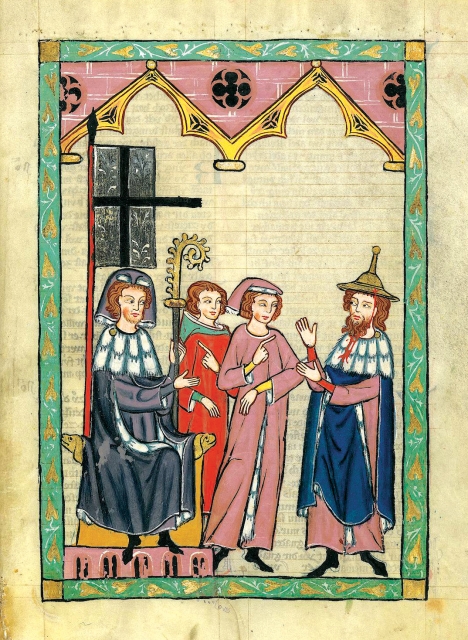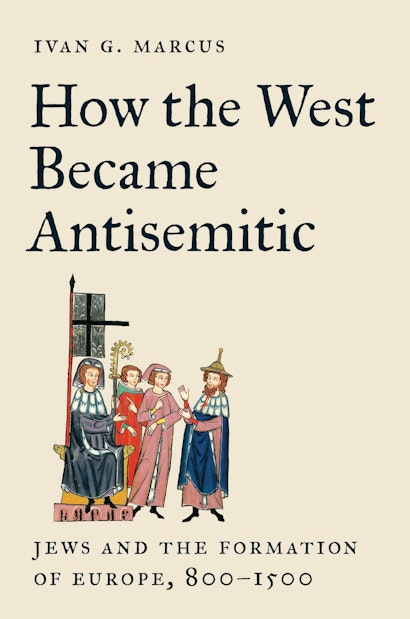The Jews—real and imagined—so challenged the Christian majority that it became a society that was religiously and culturally antisemitic in new ways between 800 and 1500. Their new self-understanding remained part of different groups’ cultural identity down to the time of the Holocaust and beyond to the present day.
Contrary to the widely accepted picture of Jewish history, medieval Jews were assertive agents. The Jews of the Middle Ages were convinced of their chosenness, and Christian rulers inadvertently reinforced Jewish solidarity by recognizing Jews as legal, self-governing communities, not just as individuals, if only to tax them better. The Jewish-Christian confrontation was grounded in a deep structural clash between two related religious cultures each of which thought itself chosen and the other excluded from divine favor. Given the different power dynamics, this meant that force would be a Christian option, but the Jews had resources as well even if limited and often ineffective. Acts of Jewish assertiveness directed against Christianity, in turn, increased Christian authorities’ anti-Jewish views and policies. Christians reasserted their claims to divine election and tried to subject the Jews to servitude unless they converted. One effect of this confrontation between two chosen cultures was to make Christian Europe antisemitic in new ways.
The story was in part symmetrical in that each culture claimed to be the one God chose in its Bible. The Hebrew Bible and New Testament agree that it is the second or later party, not the first, that is God’s chosen one, and Jews and Christians each claimed to be the second. In the Hebrew Bible the Israelites displace the Canaanites who are there first, and the younger sons, Isaac and Jacob, displace the elder sons Ishmael and Esau. In the latter case the Bible says that the elder shall serve the younger (Gen 25: 23). The Christian reading of those texts read the Church as Isaac and Jacob and the Jews as Ishmael and Esau who were to serve the younger, Jacob as the Church.
Despite this symmetry about rival claims to being chosen, an important asymmetry developed in medieval Europe. Although most rabbinical leaders viewed their Christian neighbors as misguided and not as pagans, they still assumed that Christianity itself was a form of forbidden “foreign worship” (‘avodah zarah). The Christian majority, on the other hand, asserted its own spiritual election and treated Jews as rejected and despised pagans and paid little attention to Judaism except as foretelling the truth of Christianity. So, medieval Christian antisemitism was directed at medieval Jews. Jewish animosity was directed at Christianity and its sancta that it associated with biblical idolatry and filth.
As the population grew in the towns of Christian Europe, Jews continued to migrate there to make a secure living in an expanding economy. Business with Christians took place first in trade and then as also as borrowers or suppliers of credit. Jews were simultaneously attracted to Christians and repelled by Christianity.
In 1095, reform Pope Urban II called for an armed pilgrimage to the Holy Land to liberate the Church of the Holy Sepulcher from “pagan” pollution, to re-establish right order there. The hysteria that the pope generated against non-Christian enemies abroad reinforced the Christian view that the Jews who lived among them now were the “enemy within.”
Jewish assertiveness assumed many forms. The Jews created an imagined Christianity that they continued to view since ancient times as a form of paganism to be avoided and derided as much as possible. And so, Jews went out of their way, when safe, to insult Christian sancta by making insulting word plays and by confronting Christians informally about their beliefs, provoking Christians to defend their faith.
Jews also denigrated Christian sancta by engaging in private and public gestures of contempt such as placing Christian images or statues in their latrines. Jews found the idea that God had been inside a woman preposterous and expressed their disgust about this idea in gestures that equated Christianity with bodily elimination, the opposite of the holy in both religious cultures.
Local competition among Benedictines in England for making new Christian saints added a new dimension to the imagined Jew augmented during the First Crusade frenzy as the nearby enemy of Christians. The imagined “enemy within” was now also thought to harm “the body of Christ” in the present, not just in the past, by ritually killing Christians (the ritual murder accusation).
The idea of the body of Christ also led Jews and Christians vigorously to argue over Jewish and Christian bodies. Depending on the context, Christians considered Jews either indistinguishable from Christians and therefore sexually threatening without external markers such as distinctive clothing. Or, in the framework of potential conversion, some Jewish physical features were thought to prevent a Jew becoming a Christian despite baptism. Thus, to the imagined Jew as subordinate, and then feared as the enemy within, a third characteristic was added, the belief that Jewish adult men could not change by conversion, and that their Jewish condition was permanent.
The imagined Jew, however defined, could not be expelled from Europe because it existed in the minds of Christian Europeans and persisted for centuries there and to wherever Europe spread its influence. Even after their expulsion from England and France, in literary works in England, we see the imagined presence of the unchangeable enemy Jewish male adult featured in Marlowe’s Jew of Malta, and Shakespeare’s Merchant of Venice.
The three factors of inverted hierarchy, internal enemy, and permanence shaped the Christian imagined Jew, and these Christian antisemitic assumptions could be transformed into modern antisemitism by replacing medieval attributes with modern ones that fit the three structural categories. The Jews were first understood to be the enemy of the Church and the Body of Christ, then became, in redefined racial categories, the enemy of the Volk.
Ivan G. Marcus is the Frederick P. Rose Professor of Jewish History at Yale University. He is the author of Piety and Society: The Jewish Pietists of Medieval Germany; Rituals of Childhood: Jewish Acculturation in Medieval Europe; The Jewish Life Cycle: Rites of Passage from Biblical to Modern Times; and Sefer Hasidim and the Ashkenazic Book in Medieval Europe.

